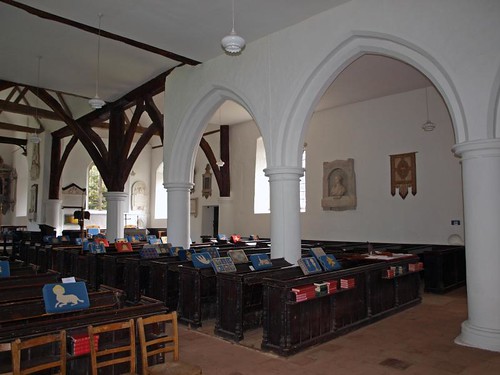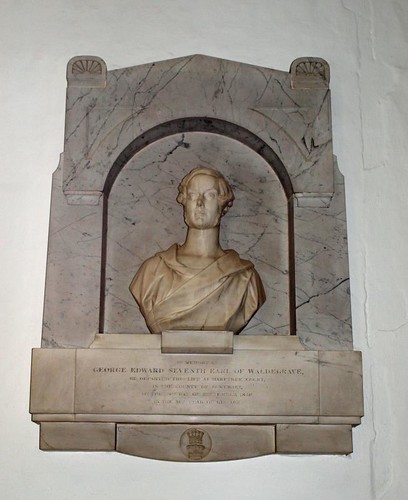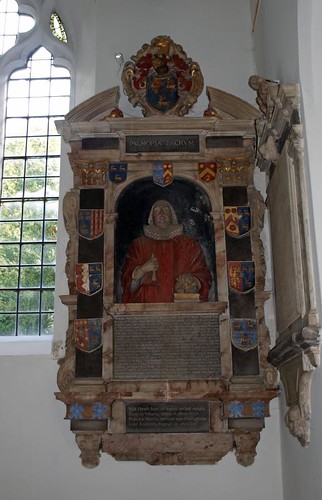ST THOMAS THE APOSTLE. At the time of writing a neglected, almost derelict-looking church. Nave N wall with plain Norman doorway. S aisle, S chancel chapel and S arcade E.E Circular piers and double-chamfered arches. The pier at the E end of the arcade and the W end of the S chancel chapel is of oak and polygonal, almost like fluted. What date can this possibly be? One blocked lancet in the S chapel, one long lancet in the S aisle. Early C14 chancel with Dec windows - the E window of three-lights with reticulated tracery. In the nave N wall at its E end a wide recess, E.E., with a shaft on the l. carrying a stiff-leaf capital. Probably in the C15 a s porch was added and also - a more ambitious enterprise - a timber tower. This stands to the W not of the nave but the aisle. It is oblong and has N and S aisles and in addition a W aisle connected with the others by triangular pieces - a rare arrangement. The tower is carried on four heavy posts, each with an octagonal shaft attached diagonally towards the centre. These shafts carry rib-like arched braces meeting in the middle in a foliage boss. - DOORS. Three with ornamental hinges; one (N doorway) is C12, the other two C13. - ORGAN. Early C18, bought from Lord Southwood’s house at Highgate, London. - PLATE. Cup and Paten of 1624; two Flagons, inscribed 1626 and 1630. - MONUMENTS. Mainly to the Waldegrave family, and singularly modest. Edward W. d. 1809, by Bacon jun, with a Weeping female allegorical figure bent over military objects, and a triumphant cherub higher up. - Seventh Earl Waldegrave d. 1846, with bust by Behnes. Also John Greene d. 1653, with frontal demi-figure. - Anne Snelling d. 1625, tiny reclining marble figure with tinier baby in her arms.
NAVESTOCK. A colossal barn, tall limes, and a huge chestnut keep company with its church, which has a shingled spire rising from an astonishing wooden belfry. The surprise of it is inside, where 15th century beams and ancient ladders seem to be in great confusion, With masses of woodwork all about us. Looking closer, we see that the four chief uprights are moulded at the capitals, and that four great beams curve up to meet in a boss of carved foliage. The belfry woodwork is oak splendid and unashamed, but the wood in the church is so covered with whitewash that we might think it stone. We see it in the wooden arch of the 14th century chancel, and in another arch across the 13th century chapel, both arches rising from an oak pillar which ends the line of round stone piers built about 1250, when the church was doubled in width.
The oldest masonry is in the north wall of the nave, which has a plain doorway of the 11th century. Four doors in the church are of remarkable age, and have well preserved their ironwork though some of the wood has been renewed. One is in the ancient Norman doorway; others of the 13th century are in aisle and chapel; and double doors of Chaucer’s day lead from the aisle into the bell tower. The porch is 15th century, and in a corner by the modern font are coffin lids of two priests about 600 years ago, one with a raised cross.
On the 17th century gravestone of little Jane Marchant, who was only 15, are two delightful lines:
So fair a blossom, so exquisitely good,
That I want words to make it understood.
In the chancel are two striking 17th century monuments, much in contrast. One has a simple alabaster figure of Ann Snelling holding her baby; the other is the bust of John Greene, a judge who seems proud of his family, for he is shown with a display of heraldry, many of the shields having the stag’s head seen again on a helmet above.
The great folk at Navestock have been the Waldegraves, many of whom sleep here. Their old house has gone but its park with a lovely lake is left, and there are monuments to remind us of them. There is a bust of the seventh earl who died in 1846; a relief of the eighth earl’s eldest son who fell at Alma; and another relief, carved by John Bacon, to the fourth earl’s son, who distinguished himself in Sir John Moore’s campaign and was shipwrecked when nearly home. The carving shows a boy unfurling a flag, his mother weeping below.
Two older monuments take us into circles more distinguished still. One is a Latin inscription to a daughter of James the Second, Henrietta, wife of that Lord Waldegrave who, as one of the king’s counsellors, had to fly with him at the Revolution. The other is an enormous wall tablet telling of the next two generations of Waldegraves, of Henrietta’s son James, the first earl, who was an able ambassador; and of her grandson the second earl, who moved for a few brief moments in the centre of the English stage. He was James Waldegrave, too, a friend of George the Second and tutor to the Prince of Wales. He married a niece of Walpole who was one of the beauties of her day and was seven times painted by Sir Joshua Reynolds. Waldegrave is chiefly remembered, however, as the man who became Prime Minister for five days (June 8-12, 1757). It happened in the early summer of 1757, and he had no wish to fill the office, but allowed himself to be nominated to please the king. His ministry never came into being, however, and nobody can have been more pleased than he when in place of it was born the famous ministry of Newcastle and Pitt, during the life of which England became supreme at sea, in India, and in North America.
Simon K -
Open. This is another famous church, attractive because of its aisled tower as at Blackmore and Mundon, and a very big church too, sprawling in a wide churchyard with just a farmhouse for company. You have to go down a track to get to it. Inside is a delight, full of light. The main feature is probably the extensive range of memorials, but a great curiosity is that the arcade is carried on rustic wooden cruck beams above the capitals of elegant fluted 13th century pillars. I liked this best of all today.
Flickr.
The oldest masonry is in the north wall of the nave, which has a plain doorway of the 11th century. Four doors in the church are of remarkable age, and have well preserved their ironwork though some of the wood has been renewed. One is in the ancient Norman doorway; others of the 13th century are in aisle and chapel; and double doors of Chaucer’s day lead from the aisle into the bell tower. The porch is 15th century, and in a corner by the modern font are coffin lids of two priests about 600 years ago, one with a raised cross.
On the 17th century gravestone of little Jane Marchant, who was only 15, are two delightful lines:
So fair a blossom, so exquisitely good,
That I want words to make it understood.
In the chancel are two striking 17th century monuments, much in contrast. One has a simple alabaster figure of Ann Snelling holding her baby; the other is the bust of John Greene, a judge who seems proud of his family, for he is shown with a display of heraldry, many of the shields having the stag’s head seen again on a helmet above.
The great folk at Navestock have been the Waldegraves, many of whom sleep here. Their old house has gone but its park with a lovely lake is left, and there are monuments to remind us of them. There is a bust of the seventh earl who died in 1846; a relief of the eighth earl’s eldest son who fell at Alma; and another relief, carved by John Bacon, to the fourth earl’s son, who distinguished himself in Sir John Moore’s campaign and was shipwrecked when nearly home. The carving shows a boy unfurling a flag, his mother weeping below.
Two older monuments take us into circles more distinguished still. One is a Latin inscription to a daughter of James the Second, Henrietta, wife of that Lord Waldegrave who, as one of the king’s counsellors, had to fly with him at the Revolution. The other is an enormous wall tablet telling of the next two generations of Waldegraves, of Henrietta’s son James, the first earl, who was an able ambassador; and of her grandson the second earl, who moved for a few brief moments in the centre of the English stage. He was James Waldegrave, too, a friend of George the Second and tutor to the Prince of Wales. He married a niece of Walpole who was one of the beauties of her day and was seven times painted by Sir Joshua Reynolds. Waldegrave is chiefly remembered, however, as the man who became Prime Minister for five days (June 8-12, 1757). It happened in the early summer of 1757, and he had no wish to fill the office, but allowed himself to be nominated to please the king. His ministry never came into being, however, and nobody can have been more pleased than he when in place of it was born the famous ministry of Newcastle and Pitt, during the life of which England became supreme at sea, in India, and in North America.
Simon K -
Open. This is another famous church, attractive because of its aisled tower as at Blackmore and Mundon, and a very big church too, sprawling in a wide churchyard with just a farmhouse for company. You have to go down a track to get to it. Inside is a delight, full of light. The main feature is probably the extensive range of memorials, but a great curiosity is that the arcade is carried on rustic wooden cruck beams above the capitals of elegant fluted 13th century pillars. I liked this best of all today.
Flickr.



No comments:
Post a Comment